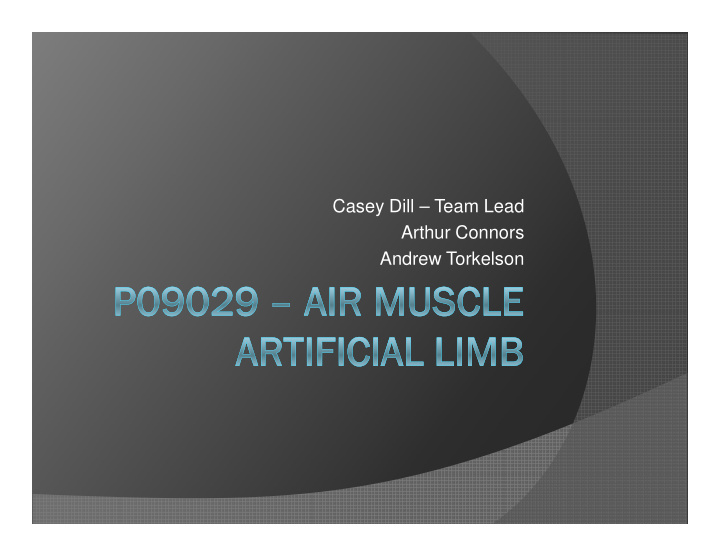



Casey Dill – Team Lead Arthur Connors Andrew Torkelson
������������ � Fourth project in artificial limb track � First three projects focused on hand DOF
������������� � To create a computer simulation of the kinematics of an air muscle-controlled human joint (the elbow) � Build a prototype joint to compare to and improve the computer model � Make end product adaptable and useful for future � Make end product adaptable and useful for future iterations
��������������
�����������������
���������� � Casey � Arthur � Andrew • � Math Theory � Controls Test Stand System Design � Pneumatics • � Electronics Test Stand � Arm Design Fabrication Fabrication � Simulation � Simulation � Arm � Arm • Testing Fabrication � Integration • Data Analysis � EDGE
�������������������
������������������
������������������
���������� Air Muscle Pressure Gauge Artificial Limb w/ Flow Restrictor Elbow joint moved by Measures and/or slows pneumatic actuators airflow Test Stand Relays Holds arm and sensors Provide power to Provide power to in place in place and control solenoid Strain Gauge Air Tank Produces voltage change with 2 count: one holds displacement pressurized air, one is vacuumed Vacuum Solenoid Pump Controls airflow Sucks air out of muscles
���������� 1) LabView first calculates what Calculating Air Pressure air pressure should be in the Fill : air muscle given the amount of ( ) ( ) t P P P P time that has passed. = − e σ + muscle 0 Tank Tank Hold : 2) LabView calculates the force the air muscles should be P P . 28 = − t muscle muscle 0 0 exerting based on the exerting based on the Drain : pressure in the air muscle given a few characteristics of ( ) t P P = e σ the air muscle. muscle 0 Apply Calculation of Force Out of McKibben Air Muscles* 2 P 1 π ( ) D 3 cos 2 1 P 2 sin 2 = muscle θ − + π θ − − F Dt t muscle k k 4 sin θ *”Measurement and Modeling of McKibben Pneumatic Artificial Muscles” by Ching-Ping Chou and Blake Hannaford
������� � Components � Pressure Tests � Elastic Cord/Strain Gauge
���������� � Air muscles – contract the way they should � Relays and Solenoid – Power works � Vacuum Pump – Failed to power up; � Vacuum Pump – Failed to power up; worked after rewiring
�������������� � Muscles filled with air at different increments (0.05, 0.125, 0.25 seconds) � Data fitted to function
��������� Test Results 90 80 70 60 50 Pressure Test 1 Test 2 40 Test 3 Test 1 30 20 10 0 0 0.5 1 1.5 2 2.5 3 3.5 -10 Time
���������!� Case Fill 90.0 Fitted Theory 80.0 70.0 60.0 60.0 Pressure (psi) 50.0 40.0 30.0 20.0 10.0 0.0 0.00 0.50 1.00 1.50 2.00 2.50 3.00 Time (sec)
������������"������������ � 6 strings, different sizes � Cord tied onto gauge � Weights 50g-2kg added � Cord displaced set amounts, voltage measured � Displacement measured � LRA to find Constant � Linear Regression to find k �������������������������������������������� ������������������������������� ������� ������� ��� ������� ��� ������������� ��� ������� ������� ��� ������� ��� ������� ��� � � � � � � ��� ��� ��� ��� ��� ������������ ����� Elastic Cord Strain Gauge k ≈ 0.212 lbs/in Constant ≈ 2347 lbs/Volt
����������
�����������������#��$$$ � Mechatronics Toolkit is a linking tool between LabVIEW and COSMOS Motion � Each program receives, translates, and � Each program receives, translates, and passes data to the next program
%�������%������ •Using a single 3-position, 5-way solenoid is cheaper than four 2-way, 2-position solenoids, and takes half of the relays. •Find local suppliers: •Find local suppliers: •Roessel has many pneumatic parts on hand. •Cross Bros has sprockets and chain on hand. •Don’t rely on non-team members for mission critical parts. •Start programming earlier.
������&��'"��������������� � Expanding to the shoulder � Refining and generalizing models � Scaling � Don’t reinvent the wheel � Don’t reinvent the wheel � Rely on past BOMs � Use updated version of SolidWorks
Recommend
More recommend